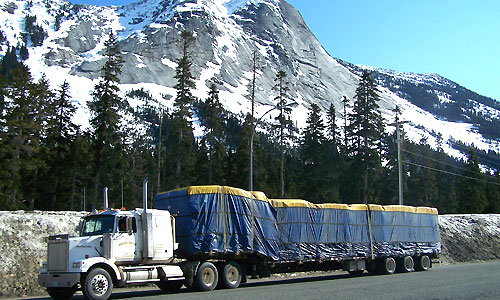
It’s the job of the Commercial Vehicle Safety Enforcement (CVSE) branch (and commercial carriers) to make sure that cargo is transported safely and efficiently across the province. The standards and regulations they follow protect our motorists and our roadways. So when it became apparent that policy concerning reducible loads was slowing down the flow of goods across the BC/Alberta border and beyond, the B.C. Ministry of Transportation and Infrastructure saw an opportunity for change and took action.
Since fall 2010, governments of the western provinces (namely British Columbia, Alberta and Saskatchewan) have been examining a number of initiatives under the New West Partnership Trade Agreement, looking for ways to simplify the transport of goods by road across our borders. The Reducible Loads Policy, which came into effect on July 4, 2011, is the result of one of these initiatives.
What are reducible loads?
In plain English, a reducible load is any item which can be broken down into smaller pieces and still remain within the dimensions and conditions of the policy. Previously existing policy dimensions have not changed, but rather what commodities can be transported under permit have. Click here for more information on the full policy.
Why did we change the policy?
Under the first policy, only non-reducible loads of large single items such as excavators, construction equipment, etc., received a permit. Over time, many exceptions regarding reducible loads had accumulated in our policies, and this policy standardizes many of those exceptions. By changing our policy to include reducible loads, we hope to simplify the transport of multiple objects by road (to the extent possible on our unique terrain) without compromising safety for truckers and other users of provincial roads.
The new policy sets some conditions, such as maximum overhang and front and rear projection, and then eases restrictions on the transportation of loads of multiple objects for term permits and small single trip permits up to 3.2 metres wide, 25 metres long (longer for a few vehicle combinations) and 4.3 metres high (4.8 m high in the Peace River Region).
- For example, one crated lawn mower 1.6 metres wide is not overdimensional, but since two mowers placed side by side would measure 3.2 metres overall width, it would be beyond legal limits. In the new policy, this arrangement would still be over legal width, but remains within the 3.2 metre policy limit and would be able to obtain an appropriate permit.
Prior to the change, there would be no legal way for this configuration to be loaded with both items, nor would it be allowable under permit. The reducible loads policy makes moving things like lawn mowers and other important, reducible items easier than ever.
Because the new policy allows a larger number of items to be hauled under a permit, we expect a real reduction in the number of trips required to haul these loads and fewer trips for commercial carriers means a reduction in our carbon footprint and the impact we have on our infrastructure as well. Change is good.
And Truckers stay off the Cel Phones!
I saw trucks with heavy things load on back and moving along road. This creates problems for other people driving cars. I think reducible load is the best way to carry heavy things in truck. In this way the risk is minimized up to great extent.
Hi there, thanks for the feedback. Yes, trucks and cars must share the road, but by increasing reducible loads and reducing travel time, our hope it that trucks carrying important cargo will be able to get to their destination quickly and safely.